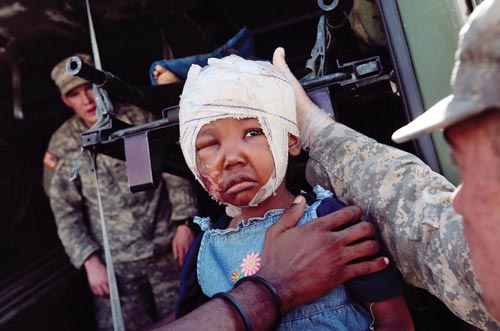-
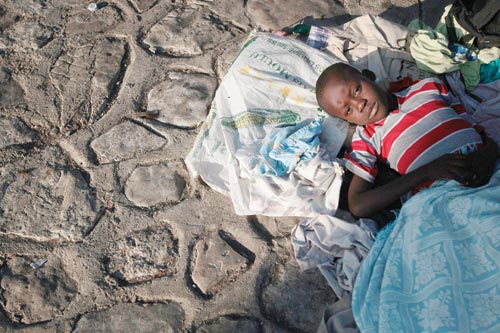
- A boy wakes on a stone plaza across the street from the National Palace, nearly a week after the earthquake that devastated Haiti.
Haiti, as it turns out, isn’t particularly prone to earthquakes. Hurricanes and political turmoil, yes: it seems that every few years Haiti is buffeted with one or the other of those, and, either way, lots of people are killed. But earthquakes aren’t much more common in Haiti than in, say, the American Midwest. So the catastrophe that devastated Port-au-Prince on January 12 was a worst-case scenario: completely unexpected and centered essentially on the national capital and largest population center by far. It’s an unbelievably cruel stroke of fate and bad luck.
I arrived as dusk was falling, a day or two after the quake struck, in a small convoy of journalists driving in from the Dominican Republic. People were saying that Haiti looked like a war zone, but I found that to be an understatement; Port-au-Prince is far more destroyed than Baghdad or Kabul or Sarajevo ever were, even in their worst days. (Dresden or Stalingrad during World War II is probably closer to the mark.) We made our way to a hotel compound that was only lightly damaged but had no services—little or no food, no power. I ate a lot of the crackers and peanut butter I’d brought with me, charged my batteries using the cigarette lighter in the truck we rented, and at night reclined the seat and slept in the truck. Others, afraid to sleep in the hotel due to the danger of aftershocks, dragged mattresses onto the front lawn and slept in the open. In the mornings, some of us would rinse off using standing water from the hotel swimming pool.
-

- Earthquake-displaced Haitians stand by their tents as the sun sets. Aid groups urged international donors to send tents to shelter the hundreds of thousands of homeless.
Those first few days, there was no escaping death. It literally surrounded us, as bodies were everywhere—on sidewalks and streets, buried in rubble and smashed inside cars. Where we couldn’t see death, we could smell its ominous, all-too-familiar stench. The main city morgue was quickly overwhelmed, and the scenes I saw there were beyond the realm of nightmares: thousands of dead bodies, overfilling the building and spread out over a huge parking lot, sometimes stacked two or three high. People would come to hastily search the piles for relatives before the bodies were cleared out by backhoe to make room for more. Some of the horrid things I saw, at the morgue and at mass graves outside of the capital, I don’t think I’ll ever tell anyone.
-
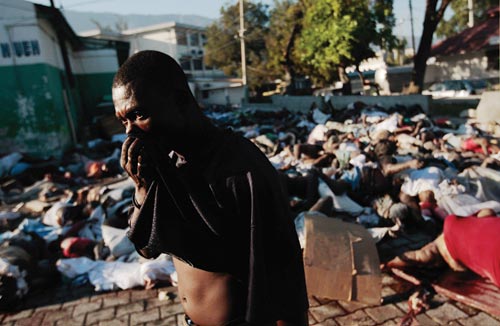
- A Haitian man turns away from the sight of hundreds of bodies piled up outside the morgue and main hospital in Port-au-Prince.
I made my way also to the central Port-au-Prince business district, a historic area of French-colonial storefronts that had been the shopping and cultural heart of the city. Once the pride of Port-au-Prince, it now looked like a movie set for a film about the end of the world. Block after endless block was smashed into rubble, and looters (many probably escaped from the central prison nearby, which emptied out in the chaos) were frenetically crawling over the twisted concrete piles like swarms of ants, looking for anything salvageable. The human toll is, of course, enormous, but the historic and architectural repercussions are catastrophic as well: downtown and elsewhere in Port-au-Prince, scores of important eighteenth- and nineteenth-century buildings that had weathered all the previous storms and turmoil came tumbling down just like that. The National Palace and the National Cathedral, Haiti’s main seats of government and religion respectively, both looked as though they’d been hit in bombing runs. A number of Haiti’s brightest young minds have been extinguished, too, since most of the universities in Port-au-Prince collapsed, likely killing thousands of college students.
-

- Belgian emergency workers struggle to free Rosemene Josiane, who had been trapped in the rubble of her house for days after the earthquake. A group of B-FAST (Belgian First Aid and Support Team) members spent most of the day trying to free one of her pinned legs; in the end, they had to anesthetize her and amputate.
The psychological effect of the massive death toll, coupled with the physical destruction of the capital, is going to be immense. Untold thousands not only died, they completely disappeared—leaving for work or school the morning of January 12, only to end up in an unmarked mass grave in the countryside a day or two later. Burial rites were denied to the dead and closure to the living. So many people were killed that Haitians even now aren’t quite sure who made it and who didn’t. My driver, Marco, has been zipping me around town; not infrequently he’ll see someone he knows and with a quick apology stop the truck and give them a long embrace. “I am so happy he is not dead,” he usually says afterward, as we continue on.
-
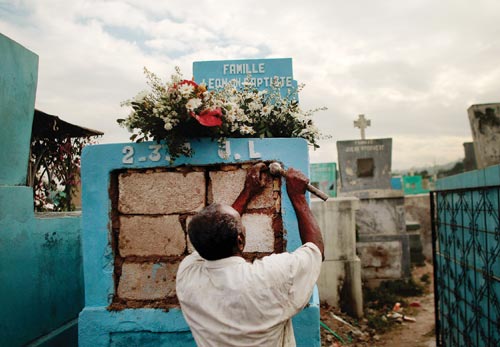
- A gravedigger seals the opening of a crypt after an earthquake victim is placed inside at the main cemetery in Port-au-Prince.
Clearly this earthquake is going to go down as one of the worst natural disasters in history. The numbers are still in flux, but it’s starting to look like the quake killed roughly the same number of people as the massive 2004 Asian tsunami—some 200,000. The tsunami was bad enough, but for one tiny country to absorb the same death toll that fourteen mostly larger ones did during the tsunami is mind-boggling. And unlike the tsunami countries or China and India after massive earthquakes, Haiti has essentially lost its capital. It’s been a long time since the capital of a nation has been hit with an event of this magnitude.
-
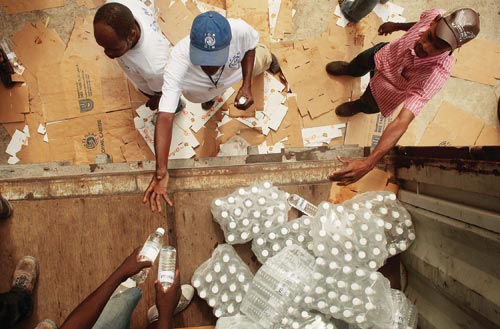
- Aid workers unload cases of water for distribution in Legoane. The historic town was near the epicenter of the 7.0 earthquake.
For my part, the many horrible things I’ve witnessed here are balanced somewhat by the scenes I also saw of immense charity and bravery. These memories are swimming in my mind, surfacing in quick flashes: Haitian students piled on the pancaked heap of one of the collapsed colleges, stone by stone removing debris in a steady effort to reach friends trapped underneath; burly US troops carrying heavy cases of water two at a time on their shoulders and loading them into a steady stream of helicopters; young Haitian men serenely escorting Haitian grandmothers to the front of food lines, while others wait politely; doctors and nurses from all over the world converging at the central hospital complex in Port-au-Prince, working out of tents and in the open air, tirelessly saving lives.
-
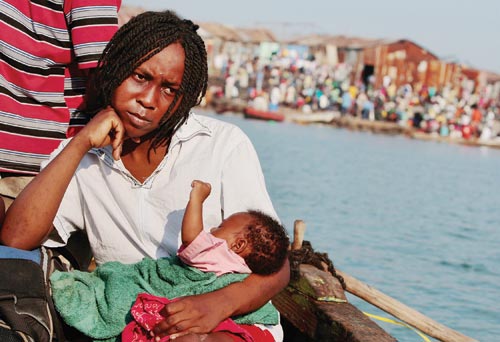
- Miche Guerieri sits on a boat with her six-week-old baby after spending three days on a crowded ship off the coast of Port-au-Prince. Hundreds of displaced Haitians took refuge on ships in the damaged port inlets, waiting for boats to help them escape from the capital.
At this hospital, doctors earmarked the most serious cases for helicopter airlift to a premier Navy medical ship floating offshore. American paratroopers from the Eighty-second Airborne were tasked with transporting these patients from the hospital to an improvised helicopter landing pad on the grounds of the destroyed National Palace. One was a boy named Paul with a grievously broken leg who winced in pain whenever he was moved; another was a brave girl named Narlee, who had been struck by a falling wall, leaving her face horribly swollen and her head wrapped in thick bandages that looked like an old-time leather football helmet. The young men of the Eighty-second loaded the children into a rugged Army ambulance, drove them to the palace, and placed the gurneys side by side on the unmowed grass. As the helicopter arrived and started to land, it whipped up the air, and the soldiers dove down to shield Paul and Narlee from the wind and flying debris—small-town American boys with pimples and crew cuts cradling Haitian children they didn’t know and would never see again. Soon the children were loaded onto the helicopter, and it quickly rose again, roaring away into the hot blue Haitian sky.









